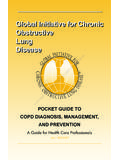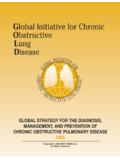Transcription of Work-related Chronic Obstructive Pulmonary …
1 This document is available from Page 1 of 8 Health and Safety Executive Work-related Chronic Obstructive Pulmonary disease in Great Britain 2017 Work-related Chronic Obstructive Pulmonary disease in Great Britain Contents Summary 2 Background 3 copd attributed to occupational exposures 3 Estimated burden of copd attributable to work 3 Occupational exposures implicated in copd 4 Compensation claims and other data sources 4 Figure 1: Annual new cases of copd among former coal miners assessed for IIDB in Great Britain, 2000-2016 4 Annex 6 National mortality data for Chronic Obstructive Pulmonary disease ( copd ) due to all causes (and predominantly smoking) 6 References 7 This document is available from Page 2 of 8 Summary Chronic Obstructive Pulmonary disease 4,000 Estimated copd deaths each year where occupational exposures contributed copd is a serious long-term lung disease which is common in later life and mainly caused by smoking. However, past occupational exposures to various dusts, fumes and vapours have also contributed to causing a substantial proportion of current cases.
2 Annual new cases of copd among former coal miners assessed for Industrial Injuries Disablement Benefit (IIDB) in Great Britain, 2000-2016 Chronic Bronchitis and emphysema are common types of copd . These are conditions in which the flow of air into the lungs is gradually reduced by damage to the lung tissue and air passages. Estimates of the proportion of total copd cases or deaths where occupational exposures have contributed are uncertain and vary across a wide range of epidemiological studies. A number of reviews have estimated values of around 15%, equivalent to about 4000 deaths per year in GB. copd among former coal miners has been recognised for Industrial Injuries Disablement Benefit (IIDB) for a number of years based on clear evidence of an increased risk. Other workplace exposures likely to contribute to copd include various dusts (including grain and silica) as well as certain fumes and chemicals (including welding fume, isocyanates, and polycyclic aromatic hydrocarbons).
3 This document is available from Page 3 of 8 Background Chronic Obstructive Pulmonary disease ( copd ) is a term used to describe a progressive and irreversible limitation in airflow in the lungs. copd includes two main diseases: Chronic Bronchitis: a condition in which inflammation narrows the air passages within the lungs (bronchi) and causes Chronic bronchial secretions; and Emphysema: a permanent destructive enlargement of the airspaces within the lung without any accompanying fibrosis of the lung tissue. Asthma may also be included within the term copd if there is some degree of Chronic airway obstruction. copd is a long-latency disease meaning that cases tend to develop a number of years after first exposure to the particular causative agents and in many cases symptoms become manifest during mid-life or later. The most important causative factor is smoking but others include occupational exposures to fumes, chemicals and dusts, as well as genetic susceptibility and environmental pollution1.
4 copd due to all causes (predominantly smoking) accounts for a substantial number of deaths in Great Britain: there were, on average, 28,000 deaths per year in total over the last 10 years with copd recorded as the underlying cause of death (see Annex). The number of people suffering from the disease at any given time (prevalence) is difficult to estimate because of different definitions of the disease and under-diagnosis. One estimate suggested that there are currently 900,000 diagnosed cases in England and Wales and that, allowing for under-diagnosis, the true prevalence could be million2. More recently, the Health Survey for England in 2010 estimated that around 6% of adults have probable airflow limitation consistent with copd , equivalent to around 3 million cases in Great Britain currently3. copd attributed to occupational exposures Estimated burden of copd attributable to work Although smoking is a particularly important factor for copd , occupational exposures to dusts gases and fumes, environmental air pollution and certain other factors also play a role.
5 Such factors will typically work together to cause cases of disease . This means that individual cases cannot be separated into those due to one cause, say, smoking, and those due to another, say, occupational exposures: in most cases where occupational exposures were a cause, smoking will also have been a cause. Estimates of the burden of Work-related copd cases can nevertheless be calculated from epidemiological research. Such estimates represent the number of cases that would not have occurred had the workplace exposures not occurred. They should not be taken as representing cases caused solely by workplace exposures rather than other factors such as smoking. Although estimates are uncertain and vary considerably, a wide range of epidemiological studies in various countries has consistently shown a substantial proportion of cases are attributed to workplace exposures. A recently updated review of the epidemiological evidence derived a best estimate of 15% of cases attributable to work4, and this is consistent with an earlier consensus view of the American Thoracic Society5.
6 The value is also consistent with recent estimates relating to the British context6 which used available estimates of copd risk due to occupational exposures from the research literature and estimates of numbers of exposed British workers; it equates to around 4000 deaths per year currently in Britain. The evidence suggests there could be around 4000 annual copd deaths in Britain, and considerably more people currently with copd , attributable to past workplace exposures. This document is available from Page 4 of 8 Occupational exposures implicated in copd Various agents and occupational groups have been implicated as being associated with an increased risk of copd . Coal dust exposure through mining activities is an established cause of copd , and cases of Chronic bronchitis and emphysema (CBE) in coal workers with a specified level of lung function impairment and at least 20 years underground exposure have been eligible for compensation under the Department for work and Pensions Industrial Injuries and Disablement Benefit (IIDB) scheme since 1993.
7 This scheme also compensates those with emphysema arising from exposure to cadmium. Epidemiological studies have identified associations between a number of other occupational exposures, including cotton dust, grain dusts and endotoxin, flour dust, welding fumes, other minerals - such as silica and man-made vitreous fibres, other chemicals - such as isocyanates, cadmium, vanadium, and polycyclic aromatic hydrocarbons (PAHs) - and wood dust1. The strength of the evidence for whether these associations indicate causal relationships between exposure and copd is stronger for some agents than others. A recent analysis of variation in the prevalence of copd by current occupational group based on the UK Biobank study a large population based study of the UK population identified a number of occupations for which the prevalence of copd was significantly higher by at least 50% compared with all other occupations, including: seafarers (and other boat operatives), coal mine operatives, industrial cleaners, roofers, packers/bottlers/canners/fillers, and horticultural trades7.
8 Additional analyses of this population are currently being carried out to further investigate these findings. Compensation claims and other data sources Assessments for Industrial Injuries Disablement Benefit (IIDB) and reports by respiratory and occupational physicians (THOR-SWORD) substantially understate the annual number of new cases of Work-related copd . Several thousand cases of Chronic bronchitis and emphysema among coal miners were assessed in the initial period following its specification as a prescribed disease in 1993 within the IIDB scheme, and changes to the prescription criteria as well as heightened publicity associated with successful civil litigation against the former British Coal Board subsequently led to a large increase in annual assessed cases the late 1990s. Over the period 2007-2016 the annual number of cases has been much lower, as shown in Figure 1. There were 70 cases in 2016 compared with 80 in 2015 and an annual average of around 110 over the period 2007-2016.
9 There have been approximately 5 new cases of emphysema due to cadmium poisoning in the period 2007-2016 within the IIDB scheme (Table IIDB01 ). All of these IIDB cases were male. Figure 1: Annual new cases of copd among former coal miners assessed for IIDB in Great Britain, 2000-2016 This document is available from Page 5 of 8 Cases of Chronic bronchitis and emphysema in relation to any occupational exposure may also be recorded by occupational and chest physicians under the SWORD surveillance scheme within The Health and Occupation Reporting (THOR) network. The numbers of new cases reported each year have typically been substantially lower than the numbers of IIDB claims. In 2016 there were 28 reports by chest physicians in the SWORD scheme compared with 17 in 2015 and a ten year average of 28, of which 10% were female (Table THORR01 ). This suggests that, even for more serious cases of Chronic bronchitis and emphysema that is, those more likely to be seen by specialist chest physicians few are being attributed to occupational causes.
10 This document is available from Page 6 of 8 Annex National mortality data for Chronic Obstructive Pulmonary disease ( copd ) due to all causes (and predominantly smoking) Age standardised rates per 100,000 population and annual deaths for the period 2006-2015 are reproduced below based on data from the Office for National Statistics (ONS) and the National Records of Scotland (NRS). Deaths are selected based on underlying cause of death coded J40-J44 (ICD10). Age standardisation is based on the European Standard Population. Age standardised copd mortality rates per 100,000 population Source: Office for National Statistics; National Records of Scotland Total annual deaths due to copd , 2006-2015 Source: Office for National Statistics; National Records of Scotland This document is available from Page 7 of 8 References 1. MRC Institute for Environment and Health (2005). Review of literature on Chronic bronchitis and emphysema and occupational exposure. Leicester, UK 2. NICE (2004).















